| 1 | Everywhere in Australian waters |
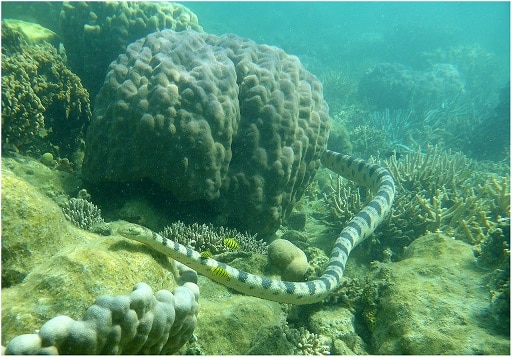
The waters surrounding Australia are infested with snakes, not just the land itself. There’s over 15 sea snake species in Australia, and the greater sea snake (Hydrophis major) is among the most common, occupying the entire north coast plus much of the west and east coasts. This is a large, venomous aquatic serpent which regularly reaches 1.5 metres. Further afield, they’re found along the coasts of New Caledonia, Papua New Guinea and eastern Indonesia.
This species isn’t fully ocean surfing like a yellow-bellied sea snake, nor a committed creature of coral reefs like the turtle-headed sea snake. Greater sea snakes are a relatively flexible species, as they typically live in shallow coastal waters 1-20 metres deep. This includes a mixture of coral reefs, sandy sediment floors, and especially seagrass beds, probably their favourite habitat of all.
For example, a study in western Australia’s Shark Bay compared greater sea snakes with elegant sea snakes (Hydrophis elegans), and found that the latter preferred open sandy waters, while Hydrophis major inhabited both, but correlated more closely with sea grass. Greater sea snakes can appear 100 metres off shore, but never in the open oceans, with no islands visible in any direction.
| 2 | Deadly, but mostly gentle |
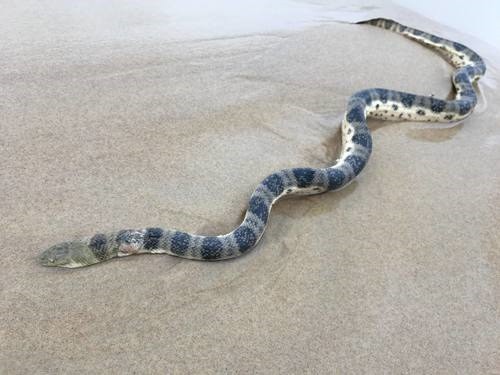
Greater sea snakes have a lethal venom which could paralyse a human and totally disable the connection between his brain and lungs. The LD50 potency is 0.19mg, versus a black mamba’s 0.05mg, and an olive sea snake’s 0.22mg. Yet they’re so docile that no deaths have ever been confirmed. It’s possible to swim past their face, just inches away, and elicit no reaction (though we still advise caution).
Greater sea snakes are olive-coloured with black markings, and an alternative name is “olive-headed sea snake”. As juveniles, their colours are sharper and more contrasting. With age, these fade into less vivid but still noticeable darker bars, which end at the flanks and don’t meet on the belly. Between each stripe, on the flanks, is a small black spot.
In the Shark Bay study above, greater sea snakes had a larger head on average, allowing them to swallow larger fish, while Hydrophis elegans had a narrower head specialised for eels, reducing the size of the prey they could swallow, but allowing them to poke into tight crevices where eels lurked. When hunting, greater sea snakes are fast-moving rather than slow and deliberate.
| 3 | Abundant in certain spots |
Greater sea snakes shed their skin every 2-6 weeks, more commonly than land snakes. They use an unusual technique, rubbing their lips against hard coral or other sea rocks, to snag the loosening skin. Then they paddle away, peeling the layer off their body slowly, leaving them with the sleek, shiny skin beneath. It’s believed that this is a defence against algae and barnacle infestations. If greater sea snakes aren’t careful, algae layers can grow so thick that they cover their eyes.
The greater sea snake is commonly stranded on beaches. A study from 1995 to 2015 analysed sea snake strandings along Queensland’s eastern coast, recording 451 strandings overall. 16 sea snake species live along this stretch, but two dominated all: the elegant sea snake (122/451), closely followed by greater sea snakes (119/451). Resist the urge to be a good samaritan and return it to the sea: picking H. major up is a rare case where people get bitten.
Like olive sea snakes, Hydrophis major has a tendency to approach scuba divers curiously, but only males, and never females and juveniles. The shocking truth is that they mistake you for females, which they’re hoping to breed with. This is another scenario for a beachgoer to get bitten, but it’s not like they realise their mistake and fly into a demented rage – they usually keep their calm demeanour.
| 4 | Tracked down by grandmas |
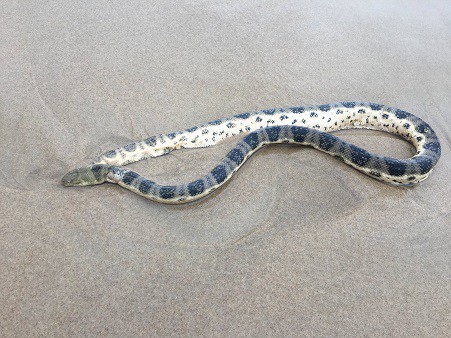
One of the greater sea snake’s global hotspots lies in Baie des Citrons, New Caledonia, a small urban bay in the town of Noumea. But this was only discovered by a gang of grandmothers in their 60s and 70s, who studied snakes in their spare time. Originally, it was scientists who surveyed Baie des Citrons from 2004 to 2012, committing 45 snorkelling hours each year. They encountered just 6 greater sea snakes, declaring them to be far less common than the local turtle-headed sea snakes.
The scientists upped their surveying game from 2013 to 2016, and this time made 52 Hydrophis major sightings, across 45 individual snakes. They were more common than once believed, but they weren’t done yet, as the grandma squad was about to arrive. These 7 older women were snorkelling enthusiasts who had long been photographing any serpents they saw just for the fun of it.
The scientists recruited them, sending the grandmas forth to gather data from October 2016 to November 2018. Over this 25 month period, the Hydrophis major sightings soared to 277, with 140 individual snakes, proving Bai des Citrons to be one of Earth’s secret greater sea snake hotspots. While never touching them, the grandmothers had swum just feet from the sea snakes while snapping photographs, demonstrating their docile personality. Not one human has been bitten by an H. major in Baie des Citrons, despite them swimming around freely.
| 5 | Nemesis: poisonous reef tentacles |
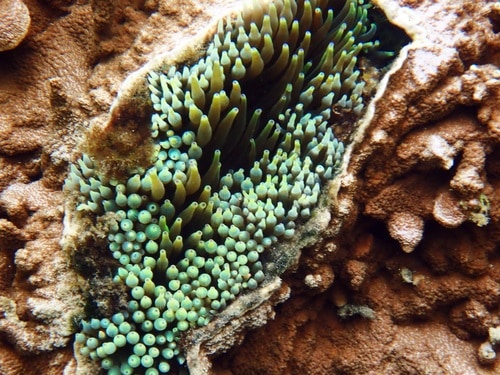
Like any snake, Hydrophis major has a list of skills (oxygen preservation, valve-like nostrils), and a list of unique pitfalls it must dodge. One of their deadly fears is the sea anemone, an aquatic organism related to jellyfish and corals, which attach themselves to rocks just like coral. Anemones resemble fleshy mushrooms, with poisonous tentacles that seize passing fish and thrust them into a hungry central mouth, like something from an alien planet.
Turtle-headed sea snakes are confirmed prey, swimming past obliviously and being seized by the tentacles. It seems that greater sea snakes are also terrified of them. In February 2014, a Hydrophis major was foraging in a coral reef, flecking its tongue, investigating crevices, and scouting about rapidly. A bubble tip anemone was hidden in one crevice, unseen by the snake. The greater sea snake probed its head into the crevice curiously. A few seconds later, it suddenly began writhing about, tying its body into knots, even biting its own body. As it ferociously writhed, the snake slowly sank to the coral reef floor. 2 minutes later, it reappeared and resumed its hunting, having survived the ordeal.
This tale happened in Baie des Citrons fringing reef, the same hotspot uncovered by the grandma squad. Anemones actually have a symbiotic relationship with certain fish, which lurk inside them without being eaten, meaning that if sea snakes aren’t careful, they might get lured in by the promise of a meal. For example, the bubble-headed anemone hosts a fish called the red and black anemonefish, which is resistant to its stinging tentacles.
| 6 | Intelligently dodges tiger sharks |
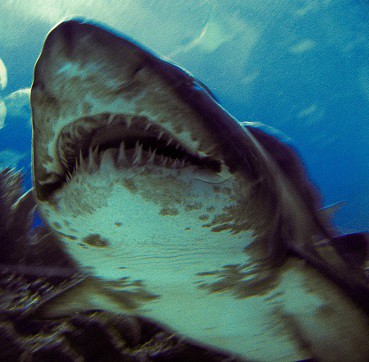
Tiger sharks are another menace greater sea snakes must contend with. Despite surfing the ocean and inspiring terrified sea creatures to flee into their coral reef crevices everywhere, sharks generally don’t hunt sea snakes, but tiger snakes are the strong exception. Olive sea snakes and banded sea kraits are particular staples.
A study from western Australia’s Shark Bay examined a colony of Hydrophis major living in seagrass flats, around 1.5-4.5 metres deep, which were bordered by deep shelves that led to deeper waters (6-12 metres), where sharks typically roamed. Numbers of tiger sharks varied, peaking during the warm months and bottoming out during the cooler months.
The study clearly found that when tiger sharks were more abundant, the greater sea snakes stuck to the interior of the seagrass beds. They avoided the edges where sharks were patrolling, where they were more likely to be hunted. The reduction wasn’t because of the outer rim snakes being eaten, as numbers in the centre actually increased. When tiger sharks were sparse, the greater sea snakes patrolled the inner and outer areas of seagrass beds in equal numbers. H. major apparently has the evolutionary instincts to dodge this nightmarish ocean predator.
| 7 | Inhabits reefs, shallows and deeps |
One study mapped out the specific habitat breakdown within Baie des Citrons, New Caledonia. The three most common species were turtle-headed sea snakes, Dubois’ sea snakes, and greater sea snakes. Turtle-heads spent the most time in coral reefs, rarely straying to sandy ocean flats between. This species feeds on fish eggs, and coral reefs provide all they need.
Dubois’ sea snakes almost always inhabited shallower waters, including beaches frequented by humans, and occasionally coral reefs. They shunned deeper waters. Greater sea snakes, meanwhile, were the most flexible species investigated. They appeared in a mixture of shallower waters, deeper sandy areas, and coral areas, moving freely through them. They tended to appear in shallower waters during the daytime, coinciding with humans, but favoured the coralline areas, which were too painful for barefooted beachgoers to walk on.
The study had a vast amount of data, as just 14 greater sea snakes were tracked, but detected a total of 37,422 times. Likewise, 4 Dubois’ sea snakes were detected 13,619 times. Greater sea snakes were confirmed as a hardy species, not reliant on one particular niche, and therefore less vulnerable to becoming locally extinct.
| 8 | Prey: definitely loves catfish |
There’s a slight mystery about the greater sea snake’s diet, with the caveat that we know they love catfish. We return to Baie des Citrons in New Caledonia yet again, the place where this species is best researched, in a study that found just a single prey item in their stomachs: the striped eel catfish (Plotosus lineatus). Catfish were all they ate, despite plenty of choice nearby.
Meanwhile, a study from Shark Bay was much more varied. While only 7 prey were discovered in Hydrophis major bellies, these included parrotfish, eels, scorpionfish, and perciformes. The nearby elegant sea snake preyed exclusively on eels, while greater sea snakes were more flexible. It’s possible that greater sea snakes prefer catfish, but happily eat other prey if they are scarce.
This diet compares to other sea snakes…
Turtle-headed sea snake – a coral reef dweller which exclusively preys on fish eggs.
Beaded sea snake – another fish egg eater, which has wandered so far down its path that it now lacks fangs.
Elegant sea snake – another common species along the northern Australian coast. Again, this focusses exclusively on eels.
Olive sea snakes – one of the least fussy, eats a huge variety of fish, including eels, shrimps, snappers, and catfish.
Banded sea krait – another sea snake which eats eels almost exclusively. Spends up to 50% of its time on land, digesting food, while greater sea snakes never stray to land deliberately.
| 9 | Ultra-attuned to catfish scents |
Hydrophis major is a well evolved hunter, as they’re highly attuned to the scent of catfish, activating into a frenzy whenever its odour particles are nearby. Scientists gathered 19 greater sea snakes from Baie des Citrons, plus Anse Vata, another bay in Noumea. They also gathered striped eel catfish, their main confirmed prey. They extracted scents from the catfish and then presented the snakes with two enclosures: a control container with normal scents, and an experimental container full of the catfish scents.
The result was clear, as the sea snakes became twice as active in the catfish container, swimming fast, flecking their tongues, and generally acting like a snake in the final, acceleratory stages of a successful hunt.
The study also found that in Baies des Cirtons, greater sea snakes hunted more when tides were falling, rather than rising. The scientists were unsure why, but speculated that low tides reduce the amount of space, confining fish to a smaller area, therefore making it the logical time for H. major to prowl for meals.
| 10 | The catfish fightback |
Meanwhile, the catfish didn’t react to the greater sea snake scents, showing no signs of panic. Many creatures worldwide are well attuned to their snake predators, such as the Texas banded gecko, which flees when exposed to night snake scents. This might make the catfish vulnerable to them, particularly given that as juveniles, striped eel catfish hang out in huge schools containing 100 apiece. But they have an extra defence, one that involves no effort on their part: brutal spines.
Catfish have spines both on their back and pectoral areas, which can easily puncture predators. In the striped eel catfish, these spines are toxic. Sea snakes can take up to 8 times longer to eat catfish than other fish, from initial capture to fully swallowed.
It’s likely that as with the US brown watersnake, which eats 60% catfish, greater sea snakes angles catfish carefully so that their spines fold up while swallowed. However, a 2020 study found something interesting, as the striped eel catfish in zones abundant with greater sea snakes had longer spines than those where they didn’t live. This popular prey has started to respond to its predator, in a case of forced evolutionary pressure.
Tiger sharks aren’t the only obstacle greater sea snakes face. If they’re not careful, they may fall victim to overconfidence, and be gradually outsmarted by the prey they once dominated.
